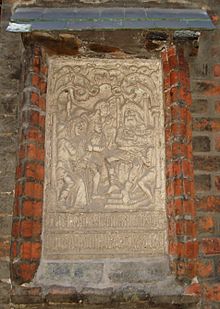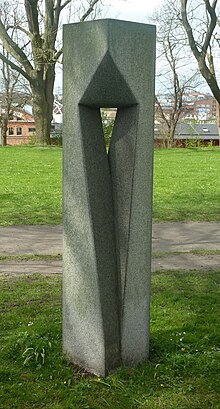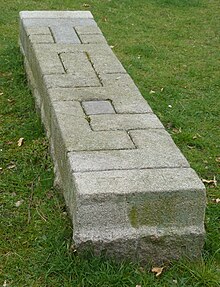Lübeck Way of the Cross

The Lübeck Way of the Cross is one of the oldest of its kind in Germany and has been used again since 1994. Of the former seven stations on the 1650 meter long path, created towards the end of the 15th century , only the first and last, beginning and end of the Way of the Cross are preserved.
Emergence
According to the tradition of the Rehbein Chronicle , which dates back to 1619, the Lübeck merchant and councilor Hinrich Constin traveled as a pilgrim to the Holy Land in 1468 and measured the Via Dolorosa there . After his return, he arranged for the path to be recreated in his home town of Lübeck in the form of a seven-station path. He did not live to see the completion of his idea in 1493. He died in 1482 and bequeathed his fortune to the city on condition that it be used to complete the Way of the Cross.
Legend
An old legend tells of the origin of the Way of the Cross in the following way:
“In 1493, in the oak wood, in front of the castle gate of Lübeck, which was called Jerusalem, the mountain Golgotha was raised by Heinrich Constin. He was a wealthy merchant and very respected. But he was furious, and so he once did such a heartache to his wife, whom he otherwise loved tenderly, that she has never wanted to recover and has finally died. From that moment on he had no rest in his homeland. So he leaves his house and his goods to a loyal and experienced servant, gives his only daughter to a pious merchant in Novgorod as a husband and moves himself to the promised land to repent and gain peace in his soul. There he showed himself so brave against the unbelievers that he was made a knight of Jerusalem. So he carefully measured all the paths and footbridges and, if God would lead him safely back to the city of Lübeck, he would erect the mountain of skulls at the place called Jerusalem of old. Since then he has become calm and peaceful, and the figure of his women has appeared to him in a dream and has promised him that God will be gracious to him because of his deep repentance. Now that he has returned, he has diligently measured everything and had it torn open, and has found that from the old courtroom at the chancellery to the Jerusalem in front of the castle gate there is exactly the same number of steps as from the Pilati courtroom to the place of the skull . Then the steps from the place where Christ carried the cross are counted and a memorial stone is placed in the wall of the Jakobikirche on Koberge, where the costume of the cross began. Likewise, from the first castle gate to Jerusalem, the length of the road is found where Simon of Cyrene took the cross for the Lord. Now when the mountain is raised and the image of the crucifixion is erected and Mr. Constin adores fervently, behold, a large ship is coming up the Trave, which leads his daughter along with her husband. They put their child, the image of his deceased wife, in his arms. Then he fell asleep softly and blissfully. But when, after many years, the stone of the crucifixion was torn by lightning, the legs remained completely intact and unbroken, as was said before: 'You should not break his leg.' Understandable people who saw it could not be surprised enough. "
course
First station (at the Jakobikirche)

The Lübeck Way of the Cross begins with a sand-lime stone relief on the north side of St. Jakobi . As the first station, it represents the Pilate's house of execution and shows the scene of the Passion story in which Jesus is dragged in front of Pontius Pilate , who literally washes his hands in innocence. The Middle Low German inscription below reads:
Hir.beginet.de.crucedracht.xsti
butē.de borchdare.to.Jherusalē.
( Christ carrying the cross
through the castle gate to Jerusalem begins here . )
Modeled on the historical model of the Via Dolorosa, the Way of the Cross then leads exactly 1650 meters from the church to the station of the cross on Jerusalemsberg ( Travemünder Allee / corner of Konstinstraße). However, the path initially led southwards along Breite Straße to the office building and from there northwards again over Koberg through Große Burgstraße out of the old town.
Second stop
The second station was on the north facade of the office building and showed the laying on of the cross.
Third station
The third station was just outside the castle gate and showed how Simon of Cyrene helped Jesus carry the cross.
Fourth to sixth stations
The three other stations, which, like the last, were designed as brick housings with a limestone plaque in a niche, were located north of the castle field . They were referred to as the Lord Christ's Three Stones' Throws, or First through Third Jerusalem , and showed Jesus collapsing under the weight of the cross for the first, second, and third times.
Seventh Station (on Mount Jerusalem)
The end of the Way of the Cross lies on an artificial hill - about four meters high, forty meters wide and sixty meters long, ramp-shaped - designed as a Calvary , which here is called Jerusalem Mountain. He carries a Gothic house (formerly with a stepped gable) in which a rough relief made of Gotland limestone is embedded. The relief is 3.30 meters high and 1.77 meters wide and shows Jesus on the cross with Mary and John. Levitating angels collect in goblets the blood that flows from Christ's wounds. The coat of arms of the founder is placed in front of the hill of the cross, which is covered with bones. An inscription that was once attached to the frame can no longer be deciphered. The relief has been restored several times. Major restorations were carried out in 1680 and 1882. A part of the complex fell victim to topographical changes during the Lübeck French era in order to ensure a free field of fire in front of the castle gate. City gardener Metaphius Theodor August Langenbuch reworked the green area in 1896.
To commemorate Konstins, the path that leads from the monument down to the Trave was named "Konstinstrasse" after him. The quay and transshipment facilities there on the Trave, the Konstinkai and the Konstinbahnhof of the Lübeck port railway , were later named.
During the National Socialist era , the Jerusalem Mountain was renamed Kreuzberg on December 3, 1936 . This renaming was reversed after 1945.
Rediscovery
After the Reformation was introduced in Lübeck by the church ordinance of Johannes Bugenhagen in 1531, the Way of the Cross was pushed out of the consciousness of the citizens as such for reasons of the new faith. Except for the first and last station, the stations were destroyed. The second station was still available in 1615 when the office building was expanded and was integrated into the then newly built New Chamber , but disappeared soon afterwards. The third station was destroyed during the renovation of the castle gate in 1623/24. Remnants of the fourth to sixth stations that Jakob von Melle saw in 1713 are said to have been cleared in 1798.
At the beginning of the 1990s, Helmut Siepenkort, the then provost of the Roman Catholic provost church Herz Jesu (Lübeck) , initiated a new way of committing the former Lübeck Stations of the Cross on Good Friday . In the following years, with the support of the Evangelical Jakobi congregation, the custom developed into an ecumenical event in which over 650 people took part in 2007, including the former Evangelical Bishop of Lübeck, Karl Ludwig Kohlwage , Provost Ralf Meister and Archbishop Werner Thissen from Hamburg .
Due to the good ecumenical cooperation of the churches in Lübeck, the Way of the Cross has acquired a new importance. It is celebrated by hundreds of people on Good Friday and songs are sung and readings heard at its stations. In short speeches, personalities from church and society, including z. B. the former Schleswig-Holstein Prime Minister Björn Engholm to translate the suffering and the message of Jesus into the here and now. The legacy of the Lübeck martyrs is often tied to. The cross is carried by people who would like to do this from station to station - there are now five stations that were completely redesigned in 2013 after a sculptor symposium.
| station | Explanation | sculpture | description |
|---|---|---|---|
| 1: Jesus before Pontius Pilate
St. Jakobi |
As the Son of God, Jesus Christ preached charity on earth. Nevertheless, he was sentenced to death by Pontius Pilate. The first station on the Way of the Cross marks the beginning of the Passion of Jesus Christ: a warning and a call to respect fundamental values such as law, humanity and tolerance. | In addition to the old relief, there is a sculpture made of corten steel next to the church, which invites you to change perspective (artist Winni Schaak ). | |
| 2: Trusting in God, Jesus walks towards death
Castle gate passage |
At this point the oldest way of the cross in Germany and the way of the four Lübeck martyrs, symbolically created in 2011, cross. In confessing to Jesus Christ and in his succession, the Lübeck clergy opposed the Nazi regime of injustice during World War II. They were executed in Hamburg on November 10, 1943. | In the passage of the castle gate there is a relief made of Corten steel on the wall, which reminds of the four martyrs who preached against National Socialism and were executed. The Gothic design connects this statement with the Way of the Cross: Jesus walks towards death trusting God. (Artist Winni Schaak) | |
| 3: Jesus collapses under the weight of the cross
Burgfeld / Gustav-Radbruch-Platz |
For part of Jesus Christ's ordeal, Simon of Cyrene takes on the burden of the cross. His help is representative of the ability to feel compassion and help people in need. A timeless sign of charity and humanity. | The sculptor Karin v. Ommeren, Holland has designed an idiosyncratic cross that breaks the boundary between inside and outside. Through the stone the view goes to the port of Lübeck. Light falls through the stone - the suffering of the cross is shone through by the sun. | |
| 4: Jesus is mocked and crucified
youth hostel |
His cross calls for solidarity and compassion for those whose dignity is disregarded. It questions the right of the fittest and at the same time reminds of the four Lübeck clergymen who did not remain silent, but preached publicly against Nazi totalitarianism and risked their lives. | Many young people meet here and the stele by Frede Troelsen, Denmark invites you to experience this place as a place of encounter, of entanglement.
Everyone lives their life, but the interlocking building blocks of the work of art remind us that all of our lives are related to one another. The interaction of the elements creates new cross shapes that question the right of the stronger. |
|
| 5: Jesus dies on the cross
Jerusalem |
Jesus accepts his death in order to save people. The crucified one questions the arrogance of powerhumanism. To turn his call to active charity into a way of life for all people is the message of his death. | Here the view falls on the relief with the representation of the Passion shown in the entrance part. Before that, like a catafalk, another new work by Frede Troelsen. Here, too, the connection between interlocking building blocks. Visitors can sit down and consider the path that Jesus walked and that everyone must walk for themselves. Sometimes the work is polished, sometimes carved - just as life shapes a person. |
.
literature
- Uwe Müller (author), Archives of the Hanseatic City of Lübeck (ed.): St. Gertrud. Chronicle of a suburban residential and recreation area . Schmidt-Römhild, Lübeck 1986 (= small booklets on city history; booklet 2), ISBN 3-7950-3300-4 .
- Johannes Baltzer a . a. (Author), Denkmalrat (ed.): Lübeck. The architectural and art monuments of the Free and Hanseatic City of Lübeck ; Volume 4: The Monasteries. The town's smaller churches. The churches and chapels in the outskirts. Thought and way crosses and the Passion of Christ . Verlag für Kunstreprod., Neustadt an der Aisch 2001, ISBN 3-89557-168-7 , pp. 623–627. (Unchanged reprint of the edition: published by Bernhard Nöhring, Lübeck 1928)
- Beate Bäumer: From Jakobi to Jerusalem - Germany's oldest way of the cross in Lübeck . Imhof Verl., Petersberg 2008, ISBN 978-3-86568-351-9 .
- Peter Schemeinda / Ingrid Sudhoff (HG) - Lübeck and the surrounding area - Part 2: [1] - therein: Chapter 24: The station of the cross at the Jerusalem Mountain in Lübeck-St. Gertrud and Chapter 31: The station of the cross at St. Jakobi
Web links
Individual evidence
- ↑ Ernst Deecke (ed.): Lübische histories and sagas . 10th, unchanged. Aufl., Schmidt-Römhild, Lübeck 1980, ISBN 3-7950-0074-2 , No. 148, pp. 146-147. (Collected by: Ernst Deecke, first edition: Boldemann, Lübeck 1852; newly edited by Werner Neugebauer)
- ^ Müller: St. Gertrud , p. 20
- ↑ Müller: St. Gertrud , p 66
- ↑ Steles for the Lübeck Way of the Cross at shz.de.
- ↑ End and beginning / Kreuzweg, 5th station at kunst-im-oefflichen-raum-luebeck.de
See also
Coordinates: 53 ° 52 ′ 51.2 " N , 10 ° 41 ′ 45.6" E






